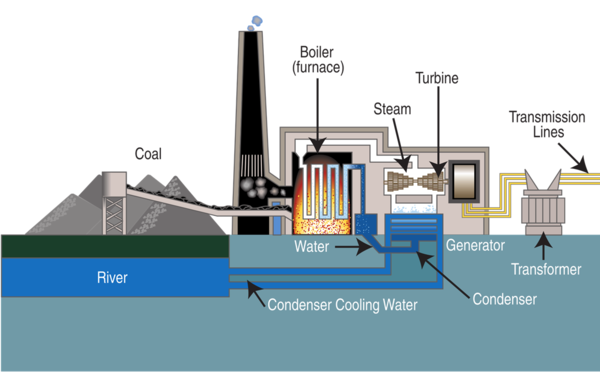Difference between revisions of "Coal"
| Line 5: | Line 5: | ||
===About Coal=== | ===About Coal=== | ||
: [[Coal]] is a [[Non-renewable Energy Resources|non-renewable energy resource]]. | : [[Coal]] is a [[Non-renewable Energy Resources|non-renewable energy resource]]. | ||
| − | : [[Coal]] has [[energy]] in its [[Chemical Potential Energy Store|chemical potential energy store]] which can be transferred into a [[Thermal Energy Store|thermal energy store]] by [[combustion]]. | + | : [[Coal]] has [[energy]] in its [[Chemical Potential Energy Store|chemical potential energy store]] which can be [[Energy Transfer|transferred]] into a [[Thermal Energy Store|thermal energy store]] by [[combustion]]. |
| + | : [[Coal]] [[product|produces]] [[Carbon Dioxide]] during [[combustion]] which [[scientist]]s have shown contributes to [[Global Warming]]. | ||
===Power=== | ===Power=== | ||
| Line 24: | Line 25: | ||
*Can work continuously. | *Can work continuously. | ||
*Few power stations needed to supply a large number of houses. | *Few power stations needed to supply a large number of houses. | ||
| + | |||
| + | ====Disadvantages==== | ||
| + | *Cost of fuel. | ||
| + | *Produce Carbon Dioxide contributing to global warming. | ||
| + | *Other pollutants produced which can harm health or produce acid rain. | ||
| + | *Coal will run out. | ||
| + | |||
| + | ==Key Stage 4== | ||
| + | ===Meaning=== | ||
| + | [[Coal]] is a [[solid]] [[Fossil Fuel]] formed in an [[anoxic]] environment from [[decompose]]d [[Plant|plants]]. | ||
| + | |||
| + | ===About Coal=== | ||
| + | : [[Coal]] is a [[Non-renewable Energy Resources|non-renewable energy resource]]. | ||
| + | : [[Coal]] has [[energy]] in its [[Chemical Potential Energy Store|chemical potential energy store]] which can be [[Energy Transfer|transferred]] into a [[Thermal Energy Store|thermal energy store]] by [[combustion]]. | ||
| + | : [[Coal]] [[product|produces]] [[Carbon Dioxide]] during [[combustion]] which [[scientist]]s have shown contributes to [[Global Warming]]. | ||
| + | |||
| + | ===Power=== | ||
| + | : [[Coal]] can be used to provide [[power]] directly buy burning it in homes, steam engines and furnaces or it can provide [[power]] by generating [[electricity]]. | ||
| + | {| class="wikitable" | ||
| + | |- | ||
| + | |[[File:CoalPowerStationDiagram2.png|center|600px]] | ||
| + | |- | ||
| + | | style="height:20px; width:200px; text-align:center;" |A [[diagram]] of a [[coal]] [[power station]]. | ||
| + | |} | ||
| + | : 1. Coal is burned in a furnace. | ||
| + | : 2. Water is heated in a boiler by the burning coal. | ||
| + | : 3. Water turns to steam and passes down pipes to turn a turbine. | ||
| + | : 4. The turbine causes a generator to spin. | ||
| + | : 5. The generator makes an electrical current. | ||
| + | |||
| + | ====Advantages==== | ||
| + | *Can work continuously. | ||
| + | *Few power stations needed to supply a large number of houses. | ||
| + | *Power supply can be varied depending on demand. | ||
====Disadvantages==== | ====Disadvantages==== | ||
Revision as of 11:41, 3 February 2019
Contents
Key Stage 3
Meaning
Coal is a solid Fossil Fuel formed from fossilised plants.
About Coal
- Coal is a non-renewable energy resource.
- Coal has energy in its chemical potential energy store which can be transferred into a thermal energy store by combustion.
- Coal produces Carbon Dioxide during combustion which scientists have shown contributes to Global Warming.
Power
- Coal can be used to provide power directly buy burning it in homes, steam engines and furnaces or it can provide power by generating electricity.
| A diagram of a coal power station. |
- 1. Coal is burned in a furnace.
- 2. Water is heated in a boiler by the burning coal.
- 3. Water turns to steam and passes down pipes to turn a turbine.
- 4. The turbine causes a generator to spin.
- 5. The generator makes an electrical current.
Advantages
- Can work continuously.
- Few power stations needed to supply a large number of houses.
Disadvantages
- Cost of fuel.
- Produce Carbon Dioxide contributing to global warming.
- Other pollutants produced which can harm health or produce acid rain.
- Coal will run out.
Key Stage 4
Meaning
Coal is a solid Fossil Fuel formed in an anoxic environment from decomposed plants.
About Coal
- Coal is a non-renewable energy resource.
- Coal has energy in its chemical potential energy store which can be transferred into a thermal energy store by combustion.
- Coal produces Carbon Dioxide during combustion which scientists have shown contributes to Global Warming.
Power
- Coal can be used to provide power directly buy burning it in homes, steam engines and furnaces or it can provide power by generating electricity.
| A diagram of a coal power station. |
- 1. Coal is burned in a furnace.
- 2. Water is heated in a boiler by the burning coal.
- 3. Water turns to steam and passes down pipes to turn a turbine.
- 4. The turbine causes a generator to spin.
- 5. The generator makes an electrical current.
Advantages
- Can work continuously.
- Few power stations needed to supply a large number of houses.
- Power supply can be varied depending on demand.
Disadvantages
- Cost of fuel.
- Produce Carbon Dioxide contributing to global warming.
- Other pollutants produced which can harm health or produce acid rain.
- Coal will run out.
